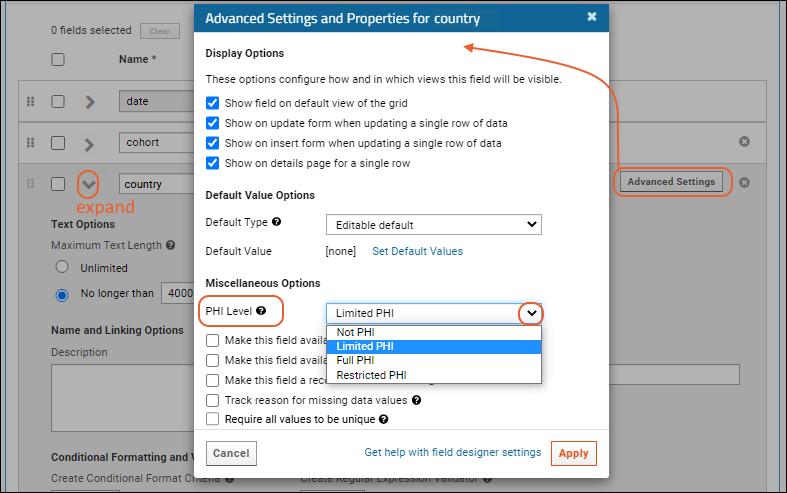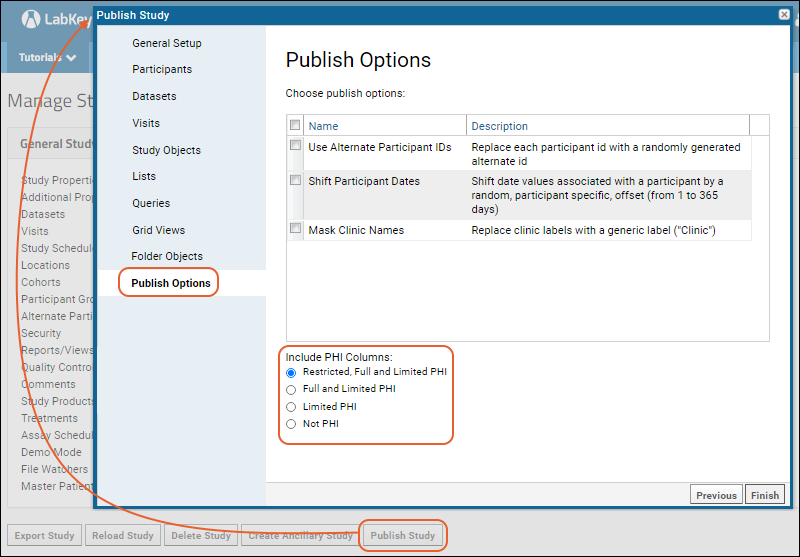Protecting PHI Data |
2024-04-24 |
In many research applications, Protected Health Information (PHI) is collected and available to authorized users, but must not be shared with unauthorized users. This topic covers how to mark columns (fields) as different levels of PHI and how you can use these markers to control access to information.Administrators can mark columns as either Restricted PHI, Full PHI, Limited PHI, or Not PHI. Simply marking fields with a particular PHI level does not restrict access to these fields, and in some cases the setting has special behavior as detailed below.
 Now that your fields are marked, you can use this information to control export and publication of studies and folders.
Now that your fields are marked, you can use this information to control export and publication of studies and folders.
 The exported archive can now be shared with users who can have access to the selected level of PHI.
The exported archive can now be shared with users who can have access to the selected level of PHI.
 The published study folder will only contain the columns at the level(s) you included.
The published study folder will only contain the columns at the level(s) you included.
- Mark Column at PHI Level
- Export without PHI
- Publish Study without PHI
- Issues List and Limited PHI: A special display behavior for issues lists.
- Use PHI Levels to Control UI Visibility of Data (Premium Feature)
Note that while you can set the PHI level for assay data fields, assays do not support using PHI levels to restrict access to specific fields in the ways described here. Control of access to assay data should be accomplished by using folder permissions and only selectively copying non-PHI data to studies.
Mark Column at PHI Level
There are four levels of PHI setting available:- Restricted PHI: Most protected
- Full PHI
- Limited PHI: Least protected
- Not PHI (Default): Not protected
- Open the Field Editor for the data structure you are marking.
- Click the Fields section if it is not already open.
- Expand the field you want to mark.
- Click Advanced Settings.
- From the PHI Level dropdown, select the level at which to mark the field. Shown here, the "gender" field is being marked as "Limited PHI".
- Click Apply.
- Continue to mark other fields in the same data structure as needed.
- Click Save when finished.
Some Columns Cannot be Marked as PHI
There are certain fields which cannot be annotated as PHI because to do so would interfere with system actions like study alignment and usability. For example, the ParticipantID in a study cannot be marked as containing PHI.Instead, in order to protect Participant identifiers that are considered PHI, you can:- Create new participantIDs unrelated to the originals and provide an additional text column for the "PHI" identifiers, marking that other column as PHI.
- Use alias IDs to map an outside "PHI" identifier to an internal alias
- Assign alternate 'randomly assigned' IDs at study export or publication time
- Use "demo mode" when showing users around a study where you want the ParticipantID to be obscured
Export without PHI
When you export a folder or study, you can select the level(s) of PHI to include. By default, all columns are included, so to exclude any columns, you must make a selection as follows.- Select (Admin) > Folder > Management.
- Click the Export tab.
- Select the objects you want to export.
- Under Options, choose which levels of PHI you want to include.
- Note that assay data does not support PHI field settings and if selected, all data will be included if selected, regardless of the PHI level you select here.
- Uncheck the Include PHI Columns box to exclude all columns marked as PHI.
- Click Export.
Publish Study without PHI
When you publish a study, you create a copy in a new folder, using a wizard to select the desired study components. On the Publish Options panel, you can select the PHI you want to include. The default is to publish with all columns.- In a study, click the Manage tab.
- Click Publish Study.
- Complete the study wizard selecting the desired components.
- On the Publish Options panel, under Include PHI Columns, select the desired levels to include.
- Click Finish.
Issues List and Limited PHI
An issue tracking list ordinarily shows all fields to all users. If you would like to have certain fields only available to users with permission to insert or update issues (Submitter, Editor, or Admins), you can set fields to "Limited PHI".For example, a development bug tracker could have a "Limited PHI" field indicating the estimated work needed to resolve it. This field would then be hidden from readers of the list of known issues but visible to the group planning to fix them.Learn more about customizing issue trackers in this topic: Issue Tracker: AdministrationUse PHI Levels to Control UI Visibility of Data
Premium Features AvailableSubscribers to the Enterprise Edition of LabKey Server can use PHI levels to control display of columns in the user interface. Learn more in this topic:
Learn more about premium editions
Note that if your data uses any text choice fields, administrators and data structure editors will be able to see all values available within the field editor, making this a poor field choice for sensitive information.
Learn more about premium editions